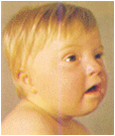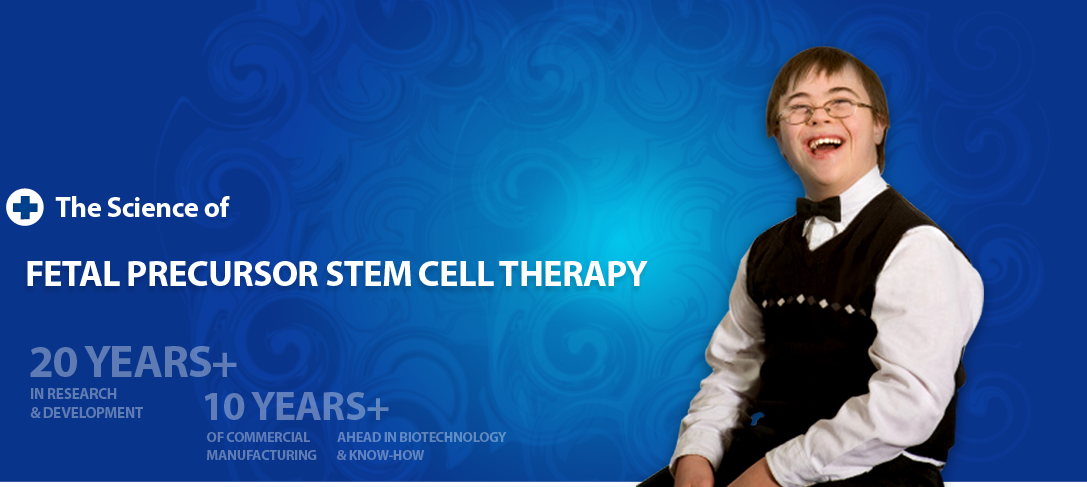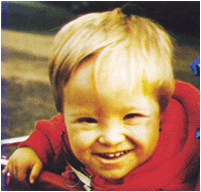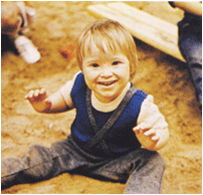| Previous |
| Comparison of a physiognomy of a male who began treatment late at the age 9 1/2 (Before), and his condition at the age 10 1/2 (After). |

7 years old |

8 years old |

9 years old |

10 years old |
|
The pictures show the transformation from an uncontrolled mimicry, to a glassy stare, to a sociable facial expression |
 |
Progress of expressive (physiognomic) changes of a Down syndrome child |

Before
a) at 1 year of age |

During
b) at two years of age |

After
c)at four years of age |
|
 |
Highly stigmatized Down syndrome girl from a high Alpine valley who, at 2.5 years of age,
|

was unable to speak; was restless, worrisome, and unmanageable |

six months after the beginning of treatment, the child already maintains eye contact and pays attention |

After four years of treatment – at 6 1/2 years of age, and after attending a normal kindergarten, the child speaks German and Italian, is enrolled in primary school on a trial basis. |
|
 |
Progress of a Down syndrome boy at: |

Before
1 1/1 years of age |

During
at three years of age |

After
at nine years of age |
|
 |
| Down syndrome boy with chronic infections |

at the beginning of treatment |

five months later |
|
 |
| Down syndrome boy with chronic infections |

Before
highly stigmatized facial expression |

After
considerable normalization of facial expression after five years of treatment |
|
 |
| Down syndrome girl at seven months of age before treatment |

Before
|

After
after 4.5 years of treatment |
|
 |
| Photographs of a Down syndrome boy between two and seven years of age (a-f) from the family album |
|
 |
 Characteristic change of appearance, mimicry, and pigmentation, of four Down syndrome children under treatment from age two to eight Characteristic change of appearance, mimicry, and pigmentation, of four Down syndrome children under treatment from age two to eight |
 |
 Physiognomy and appearance (phenotype) of Down syndrome children treated from ages five to fourteen Physiognomy and appearance (phenotype) of Down syndrome children treated from ages five to fourteen |
 |
 Facial expression and appearance of Down syndrome children under treatment since one year of age Facial expression and appearance of Down syndrome children under treatment since one year of age |
 |
 Representative cross-section of the appearance of treated Down syndrome boys from age four to fourteen Representative cross-section of the appearance of treated Down syndrome boys from age four to fourteen |
 |
| BOY : Marcus |

Marcus as an infant |

Still unable to walk |

Marcus on the potty |
|

Marcus and his younger sister. |

The siblings in a sleeping bag |
 |
 |
 |
 |
|
| Play is hard work for the small boy. Marcus “works” with educational toys (coordinating, assigning). |
|
|






























 Characteristic change of appearance, mimicry, and pigmentation, of four Down syndrome children under treatment from age two to eight
Characteristic change of appearance, mimicry, and pigmentation, of four Down syndrome children under treatment from age two to eight Physiognomy and appearance (phenotype) of Down syndrome children treated from ages five to fourteen
Physiognomy and appearance (phenotype) of Down syndrome children treated from ages five to fourteen Facial expression and appearance of Down syndrome children under treatment since one year of age
Facial expression and appearance of Down syndrome children under treatment since one year of age Representative cross-section of the appearance of treated Down syndrome boys from age four to fourteen
Representative cross-section of the appearance of treated Down syndrome boys from age four to fourteen







